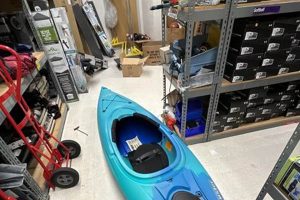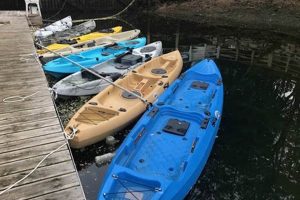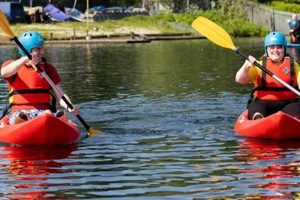Kayaking offers a unique way to experience waterways. It involves paddling a small, narrow watercraft through lakes, rivers, and oceans. Using a double-bladed paddle, the paddler propels and steers the vessel, allowing for close interaction with the natural environment. This activity can range from leisurely paddles on calm water to challenging navigations of whitewater rapids.
The low-impact nature of this watersport makes it accessible to a wide range of individuals, offering physical benefits such as improved cardiovascular health and upper body strength. Furthermore, it provides an opportunity to connect with nature, promoting mental well-being and stress reduction. From its origins as a hunting and transportation method for indigenous peoples, it has evolved into a popular recreational activity enjoyed worldwide.
This introduction provides a foundation for further exploration of specific kayaking topics, such as equipment selection, paddling techniques, safety procedures, and popular destinations. Understanding the fundamentals outlined above will enhance the reader’s comprehension of more detailed information.
Kayaking Tips
Proper preparation and technique enhance safety and enjoyment on the water. The following tips offer guidance for a successful kayaking experience.
Tip 1: Dress for the Water, Not the Weather. Because immersion is always a possibility, attire should provide protection in case of a capsize. Consider quick-drying fabrics and avoid cotton, which loses its insulating properties when wet.
Tip 2: Always Wear a Personal Flotation Device (PFD). A PFD is essential safety equipment and should be worn at all times, regardless of swimming ability or perceived water conditions.
Tip 3: Check Weather Forecasts and Water Conditions. Understanding potential hazards like wind, tides, and currents is crucial before embarking on any kayaking trip.
Tip 4: Learn Basic Paddling Strokes. Mastering fundamental strokes like the forward stroke, reverse stroke, and sweep stroke allows for efficient maneuvering and control.
Tip 5: Practice Self-Rescue Techniques. Knowing how to re-enter a kayak after a capsize is a vital safety skill that should be practiced in a controlled environment.
Tip 6: Inform Someone of Your Paddling Plan. Sharing trip detailsincluding intended route, launch time, and expected returnwith a responsible individual ensures assistance can be summoned if needed.
Tip 7: Respect Wildlife and the Environment. Maintain a safe distance from wildlife, avoid disturbing natural habitats, and pack out all trash to minimize environmental impact.
By adhering to these guidelines, paddlers can increase their safety, improve their skills, and foster a deeper appreciation for the natural environment.
These practical tips provide valuable insights for both novice and experienced kayakers. Implementing these recommendations will contribute to more enjoyable and safer experiences on the water.
1. Balance
Balance forms the foundation of a successful kayaking experience. A stable center of gravity within the kayak allows for efficient paddling and maneuvering, while instability can lead to capsizing. Several factors influence balance, including kayak design, water conditions, and paddler posture. Wider kayaks offer greater initial stability, beneficial for beginners, while narrower kayaks are more maneuverable but require more refined balance. Calm, flat water presents fewer balance challenges compared to choppy or turbulent conditions. Maintaining a relaxed yet upright posture with a slight bend in the knees allows for dynamic adjustments to shifts in weight distribution.
Understanding the interplay between these factors is crucial for maintaining balance. For example, in rough water, lowering one’s center of gravity by leaning slightly towards the oncoming waves can enhance stability. Similarly, adjusting paddle strokes to counterbalance external forces, such as wind or current, helps maintain equilibrium. Practicing basic paddling techniques in calm water allows individuals to develop a feel for the kayak’s responsiveness and improve their overall balance. Furthermore, proper weight distribution within the kayak itself contributes significantly to stability. Distributing gear evenly and avoiding overloading can prevent tipping.
Mastering balance in a kayak enhances not only safety but also paddling efficiency and enjoyment. It allows for more precise maneuvering, reduces the risk of capsizing, and conserves energy by minimizing unnecessary corrective movements. Challenges to balance will inevitably arise due to changing water conditions or unexpected movements, but a solid understanding of the principles of balance allows for more effective responses, promoting a more confident and enjoyable kayaking experience. This underscores the significance of balance as a fundamental skill in kayaking.
2. Paddle Strokes
Paddle strokes are integral to maneuvering and propelling a kayak. They represent the primary means of interaction between the paddler and the water, translating human effort into controlled movement. Effective strokes maximize efficiency and minimize wasted energy, allowing for longer paddling distances and enhanced responsiveness. Conversely, inefficient strokes can lead to fatigue, reduced control, and ultimately, a less enjoyable experience. The relationship between paddle strokes and kayaking is one of direct cause and effect: the quality of the stroke directly impacts the quality of the ride. For example, a strong forward stroke propels the kayak efficiently across the water, while a well-executed sweep stroke allows for quick turns without significant loss of momentum. Understanding the nuances of different strokes empowers paddlers to navigate diverse water conditions and achieve specific maneuvering objectives.
Several key strokes form the basis of kayaking. The forward stroke, as the name suggests, provides primary propulsion. The reverse stroke allows for stopping and moving backward. Sweep strokes facilitate turning, while draw strokes move the kayak laterally. Each stroke involves a specific combination of body mechanics and blade angles to maximize power transfer and minimize resistance. Consider the forward stroke: a proper technique involves rotating the torso and engaging core muscles, rather than relying solely on arm strength. This generates a more powerful and efficient stroke, reducing fatigue and maximizing forward momentum. Similarly, the sweep stroke utilizes a wide arc to turn the kayak effectively, minimizing the need for corrective strokes. Mastering these techniques offers significant practical advantages, particularly in challenging conditions like wind or current, where precise control and efficient propulsion are crucial.
Proficiency in paddle strokes is fundamental to successful kayaking. The ability to execute various strokes effectively not only enhances maneuverability and efficiency but also contributes significantly to safety. A strong forward stroke can help paddlers navigate swiftly through challenging currents, while a well-timed reverse stroke can prevent collisions. Furthermore, mastery of these techniques allows for greater enjoyment of the sport, opening up possibilities for exploring different waterways and undertaking more ambitious paddling trips. The connection between paddle strokes and the overall kayaking experience is undeniable: proficient strokes are the key to unlocking the full potential of this rewarding activity.
3. Water safety
Water safety is paramount in kayaking. The inherent risks associated with navigating bodies of water necessitate a proactive approach to safety management. Understanding and mitigating potential hazards, such as changing weather conditions, cold water immersion, and navigation challenges, is crucial for preventing accidents and ensuring a positive experience. Neglecting safety precautions can have severe consequences, ranging from equipment damage and minor injuries to life-threatening situations. A clear understanding of water safety principles, coupled with responsible behavior, forms the foundation of a safe and enjoyable kayaking trip. For instance, consistently wearing a personal flotation device (PFD) significantly reduces the risk of drowning in the event of a capsize. Similarly, checking weather forecasts before embarking on a kayaking excursion allows paddlers to avoid potentially hazardous conditions like strong winds or thunderstorms. These proactive measures underscore the direct relationship between water safety awareness and positive outcomes in kayaking.
Practical applications of water safety principles extend beyond basic precautions. Knowledge of self-rescue techniques, such as re-entering a kayak after a capsize, equips paddlers to handle unexpected situations confidently. Understanding how to signal for help in case of an emergency is equally crucial. Furthermore, carrying essential safety equipment, including a whistle, first-aid kit, and communication device, enhances preparedness for unforeseen circumstances. Consider a scenario where a kayaker encounters unexpected strong currents: knowledge of proper paddling techniques and self-rescue procedures could prove vital in preventing a dangerous situation. Similarly, the ability to contact emergency services using a waterproof communication device can be life-saving if a kayaker becomes injured or lost. These practical examples demonstrate the tangible benefits of prioritizing water safety.
Water safety is not merely a set of rules but an integral component of responsible kayaking. It encompasses a comprehensive understanding of potential hazards, proactive planning, and the acquisition of essential safety skills. Challenges such as unpredictable weather patterns and varying water conditions necessitate continuous vigilance and adaptability. By prioritizing water safety, kayakers not only mitigate risks but also cultivate a deeper respect for the aquatic environment. This approach fosters a culture of safety and responsible enjoyment, ensuring that kayaking remains a rewarding and enriching activity. Ultimately, the integration of water safety principles enhances not only personal safety but also the overall kayaking experience.
Navigation skills are essential for safe and efficient kayaking. These skills enable paddlers to plan routes, maintain bearings, and reach destinations successfully. Effective navigation minimizes the risk of becoming lost or disoriented, especially in unfamiliar waters or challenging conditions. A strong understanding of navigational principles allows for confident exploration and enhances overall enjoyment on the water.
- Chart Reading and Interpretation
Understanding nautical charts, including symbols, scales, and depths, is fundamental to planning kayak routes. Charts provide crucial information about potential hazards, navigable channels, and landmarks. Interpreting this information correctly allows paddlers to anticipate challenges, select appropriate routes, and navigate safely. For example, recognizing a symbol indicating shallow water on a chart can prevent grounding or damage to the kayak. Similarly, understanding the scale of a chart allows for accurate estimation of distances and travel times.
- Compass Use
A compass provides a reliable directional reference, particularly in conditions of limited visibility or featureless landscapes. Knowing how to orient a map using a compass, take bearings, and follow a designated course is crucial for maintaining direction and reaching intended destinations. In open water or areas with dense fog, a compass becomes an indispensable navigational tool, ensuring that paddlers stay on course and avoid becoming disoriented. Regularly checking the compass against visible landmarks helps confirm accuracy and reinforces navigational awareness.
- GPS Technology
GPS devices offer precise location information and can be invaluable for navigation, especially in complex waterways or unfamiliar environments. Using GPS in conjunction with charts enhances situational awareness and simplifies route planning. Features like waypoint marking and track logging allow paddlers to monitor progress, identify points of interest, and retrace their route if necessary. For instance, a GPS can help kayakers navigate through a maze of islands or locate a specific landing point in a remote area. The integration of GPS technology enhances navigational precision and safety.
- Natural Navigation Techniques
Observing natural indicators, such as the position of the sun, prevailing wind direction, and water flow patterns, can supplement traditional navigation methods. While not as precise as compass or GPS navigation, these techniques provide valuable contextual information and enhance overall awareness of the surrounding environment. For example, observing the direction of flowing water can help kayakers understand tidal currents or river flow, aiding in route planning and efficient paddling. These skills become particularly relevant in situations where electronic navigation tools may malfunction or be unavailable.
Proficient navigation skills are essential for successful and safe kayaking experiences. They empower paddlers to explore with confidence, minimize risks associated with disorientation or getting lost, and enhance the overall enjoyment of being on the water. By combining traditional methods like chart reading and compass use with modern GPS technology and an understanding of natural indicators, kayakers can navigate effectively in diverse environments and conditions. This comprehensive approach to navigation ensures safer and more rewarding journeys on the water.
5. Equipment Preparation
Equipment preparation directly impacts the quality and safety of a kayaking experience. Appropriate and well-maintained equipment contributes significantly to comfort, performance, and risk mitigation. Negligence in this area can lead to discomfort, compromised safety, and potentially hazardous situations. The relationship between equipment preparation and kayaking is one of essential interdependence: proper preparation enhances the experience, while inadequate preparation detracts from it. For example, a properly fitted personal flotation device (PFD) ensures both comfort and safety, while a damaged or ill-fitting PFD compromises both. Similarly, using a kayak paddle of appropriate length and material enhances paddling efficiency and reduces strain, whereas an unsuitable paddle can lead to fatigue and discomfort. Understanding this connection underscores the importance of equipment preparation as a fundamental aspect of kayaking.
Several key elements constitute essential kayaking equipment. A well-maintained kayak, appropriate for the intended water conditions, forms the foundation. A properly fitted PFD is non-negotiable for safety. A paddle of suitable length and material enhances paddling efficiency. Appropriate clothing, including quick-drying layers and water shoes, provides comfort and protection from the elements. Additional equipment, such as a bilge pump, spray skirt, and dry bag, can further enhance safety and convenience depending on the type of kayaking and environmental conditions. Consider sea kayaking in cold water: a wetsuit or drysuit becomes essential for thermal protection, while a spray skirt prevents water from entering the cockpit. Alternatively, for recreational kayaking on a calm lake, a comfortable seat cushion and a hat for sun protection might be sufficient. The specific equipment needs vary depending on the context, but the underlying principle remains constant: proper preparation enhances both safety and enjoyment.
Thorough equipment preparation contributes significantly to a positive kayaking experience. It mitigates potential risks, enhances performance, and allows for a more comfortable and enjoyable time on the water. Challenges such as changing weather conditions or unexpected equipment malfunctions can be addressed more effectively with adequate preparation. A well-maintained first-aid kit and a repair kit for minor gear issues can prove invaluable in such situations. Ultimately, diligent equipment preparation reflects a commitment to safety and a respect for the activity, fostering a more confident and rewarding kayaking experience. This underscores the critical connection between equipment preparation and a successful outing.
Frequently Asked Questions about Kayaking
This section addresses common queries regarding kayaking, aiming to provide clear and concise information for both novice and experienced paddlers.
Question 1: What are the essential safety precautions for kayaking?
Essential safety precautions include wearing a properly fitted personal flotation device (PFD), checking weather forecasts and water conditions before embarking, informing someone of the paddling plan, and carrying essential safety equipment such as a whistle, first-aid kit, and communication device. Knowledge of self-rescue techniques and basic paddling strokes is also highly recommended.
Question 2: How does one choose the right kayak?
Kayak selection depends on intended use and individual preferences. Factors to consider include kayak type (sit-on-top vs. sit-inside), length, width, and material. Beginners often benefit from wider, more stable kayaks, while experienced paddlers may prefer longer, more maneuverable designs. Researching different kayak types and seeking expert advice can aid in making an informed decision.
Question 3: What are the basic paddling techniques?
Fundamental paddling techniques include the forward stroke, reverse stroke, sweep stroke, and draw stroke. Each stroke serves a specific purpose in propelling, steering, and maneuvering the kayak. Learning proper technique maximizes efficiency and reduces fatigue. Instruction from experienced paddlers or certified instructors is beneficial for developing proper form.
Question 4: What should one do if a kayak capsizes?
In the event of a capsize, the primary objective is to remain calm and stay with the kayak. Attempting to re-enter the kayak using a self-rescue technique or seeking assistance from a nearby paddler are recommended courses of action. Prior practice of self-rescue techniques in a controlled environment is crucial for effective execution in a real-world scenario.
Question 5: Where are suitable locations for kayaking?
Suitable kayaking locations vary depending on skill level and desired experience. Calm lakes and slow-moving rivers are ideal for beginners, while experienced paddlers may explore more challenging environments such as coastal waters or whitewater rapids. Researching local waterways and consulting with experienced kayakers can help identify appropriate locations based on skill level and preferences.
Question 6: What environmental considerations should kayakers keep in mind?
Respecting the environment is crucial for responsible kayaking. Minimizing impact on wildlife, avoiding disturbing natural habitats, and adhering to Leave No Trace principles are essential practices. Proper disposal of trash, avoiding sensitive areas, and maintaining a safe distance from wildlife contribute to preserving the natural beauty of kayaking destinations.
Understanding these frequently asked questions enhances preparedness and promotes responsible enjoyment of kayaking. Prioritizing safety, acquiring necessary skills, and respecting the environment contribute significantly to positive and rewarding kayaking experiences.
The next section delves into advanced kayaking techniques, building upon the foundational knowledge presented thus far.
Kayaking
This exploration of kayaking has highlighted the multifaceted nature of the activity. From the fundamental principles of balance and paddle strokes to the critical importance of water safety and navigation skills, each aspect contributes significantly to a successful and rewarding experience. Proper equipment preparation further enhances both safety and enjoyment, allowing paddlers to confidently navigate diverse waterways. Understanding these interconnected elements provides a comprehensive foundation for engaging with the sport responsibly and skillfully.
Kayaking offers a unique opportunity to connect with nature, challenge oneself physically and mentally, and explore the world from a different perspective. Continued learning and practice are essential for refining skills and expanding horizons. The journey of kayaking extends beyond mere recreation; it represents an ongoing exploration of personal capabilities and a deeper appreciation for the natural world.






